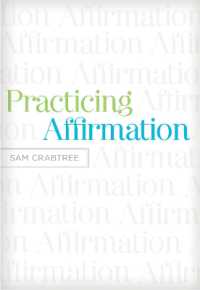- ホーム
- > 洋書
- > 英文書
- > Cinema / Film
Full Description
Tell more effective visual stories by learning the "grammar" of cinematic language with this elegant, accessible reference. Discover what you absolutely need to know to cut your own film or video, shot by shot. Whether you're a whiz with Avid or just discovered iMovie, the third edition of Grammar of the Edit gives you the answers to those all-important questions: WHEN to cut and WHY. Designed as an easy-to-use guide, the book presents each topic succinctly with clear photographs and diagrams illustrating the key concepts, and is a staple of any serious editor's or filmmaker's library.The companion website, www.focalpress.com/cw/bowen, offers further instruction with video examples of different editing choices, types of shot transitions, photographs to further illustrate concepts, and exercises to practice your editing craft. New to this edition: * Expanded discussions of the building blocks of editing* Fresh illustrations and visual examples* Updated appendices with helpful resources* Exercises and projects to help you practice your skills* End-of-chapter quizzes to test your grasp of key conceptsA simple and clear overview of the principles of editing, Grammar of the Edit, Third Edition will help you to think and "feel" like an editor. Together with its companion volume, Grammar of the Shot, these books are exactly what the beginning filmmaker needs to start producing professional quality material today!
Contents
IntroductionChapter 1 Editing BasicsA Little Editing HistoryWhat Factors May Impact Your Editing Choices?The Basic Editing TransitionsStages of the Editing ProcessReviewChapter 2 Understanding the FootageBasic Shot TypesShot DescriptionsIncreasing Shot ComplexitySimple ShotsComplex ShotsDeveloping ShotsReviewing the Footage-Selecting the Best ShotsWhat Could Make or Break a Shot? FocusAudio QualityExposure and Color TemperatureFraming and CompositionScreen Direction180 Degree Rule/Axis of Action30 Degree RuleMatching AnglesMatching Eye-LineContinuity of ActionContinuity of DialoguePerformanceBe Familiar with All the FootageSo How Does All of This Help You? ReviewChapter 3 When to Cut and Why?What Factors Help Make a Transition a Good Edit?InformationMotivationShot CompositionCamera AngleContinuitySoundIs there a Right or Wrong Reason for a Cut?ReviewChapter 4 Transitions and Edit CategoriesThe CutThe DissolveThe WipeThe FadeThe Five Major Categories of Edit TypesWill I Be Quizzed on Any of This?ReviewChapter 5 General Practices for EditorsSound and Vision are Partners and Not RivalsA New Shot Should Contain New InformationThere Should Be a Reason for Every EditObserve the Action LineSelect the Appropriate Form of EditThe Better the Edit, the Less It Is NoticedEditing is CreatingReviewChapter 6 Working PracticesWorking PracticesReviewChapter 7 The Final Cut: Additional Editing Topics You are Bound to EncounterAdditional Editing TermsMaking Your Way into the World of EditingDigital WorkflowThe Role of an Assistant EditorIn ConclusionReviewGlossaryIndex







